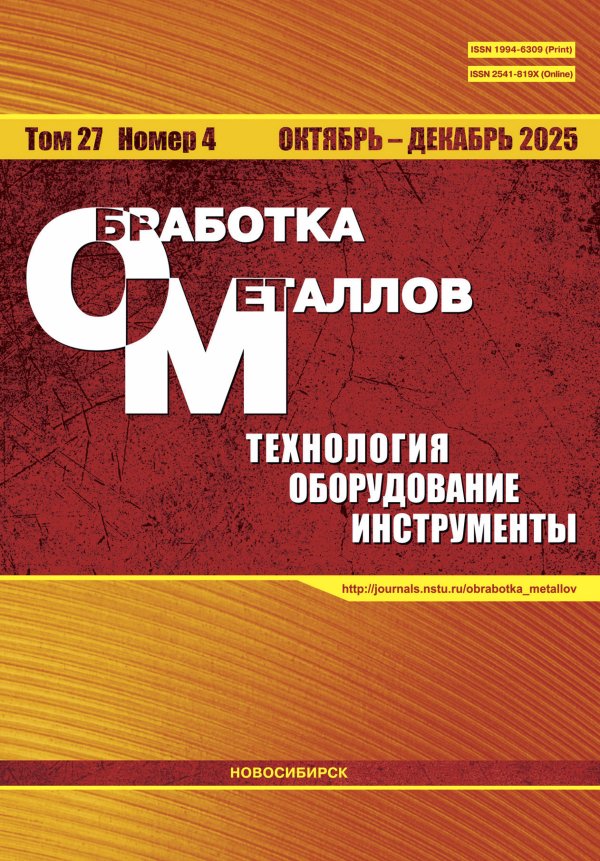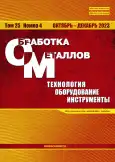Синергетический подход к разработке легкого пористого металлического пеноматериала на основе алюминия с использованием литейно-металлургического метода
- Авторы: Шарма Ш.С.1, Хатри Р.1, Йоши А.1
-
Учреждения:
- Выпуск: Том 25, № 4 (2023)
- Страницы: 255-267
- Раздел: МАТЕРИАЛОВЕДЕНИЕ
- URL: https://bakhtiniada.ru/1994-6309/article/view/301474
- DOI: https://doi.org/10.17212/1994-6309-2023-25.4-255-267
- ID: 301474
Цитировать
Аннотация
Ключевые слова
Об авторах
Ш. С. Шарма
Email: shyamsunder.sharma@jaipur.manipal.edu
доктор техн. наук, Манипалский университет, Джайпур, Раджастан, 303007, Индия, shyamsunder.sharma@jaipur.manipal.edu
Р. Хатри
Email: rahul.khatri@jaipur.manipal.edu
доцент, Манипалский университет, Джайпур, Раджастан, 303007, Индия, rahul.khatri@jaipur.manipal.edu
А. Йоши
Email: anuragjoshi355@gmail.com
доктор техн. наук, доцент, Манипалский университет, Джайпур, Раджастан, 303007, Индия, anuragjoshi355@gmail.com
Список литературы
- Comparative study of stir casting and infiltration casting of expanded glass-aluminium syntactic foams / S. Broxtermann, M.M. Su, H. Hao, T. Fiedler // Journal of Alloys and Compounds. – 2020. – Vol. 845. – P. 155415. – doi: 10.1016/j.jallcom.2020.155415.
- Banhart J. Light?metal foams history of innovation and technological challenges // Advanced Engineering Materials. – 2013. – Vol. 15 (3). – P. 82–111. – doi: 10.1002/adem.201200217.
- Banhart J., Seeliger H.?W. Aluminium foam sandwich panels: manufacture, metallurgy and applications // Advanced Engineering Materials. – 2008. – Vol. 10 (9). – P. 793–802. – doi: 10.1002/adem.200800091.
- Investigation on the effect of aluminium foam made of A413 aluminium alloy through stir casting and infiltration techniques / R. Karuppasamy, D. Barik, N.M. Sivaram, M.S. Dennison // International Journal of Materials Engineering Innovation. – 2020. – Vol. 11 (1). – P. 34–50. – doi: 10.1504/IJMATEI.2020.104790.
- Sharma S.S., Rajpoot Y.S. Development of aluminum metal foam using blowing agent // IOP Conference Series: Materials Science and Engineering. – 2018. – Vol. 377 (1). – P. 012150. – doi: 10.1088/1757-899X/377/1/012150.
- Ghaleh M.H., Ehsani N., Baharvandi H.R. High-porosity closed-cell aluminum foams produced by melting method without stabilizer particles // International Journal of Metalcasting. – 2021. – Vol. 15. – P. 899–905. – doi: 10.1007/s40962-020-00528-w.
- Farahani M.R., Rezaei Ashtiani H.R., Elahi S.H. Effect of zinc content on the mechanical properties of closed-cell aluminum foams // International Journal of Metalcasting. – 2022. – Vol. 16 (2). – P. 713–722. – doi: 10.1007/s40962-021-00635-2.
- Byakova A.V., Gnyloskurenko S.V., Nakamura T. Effect of CaCO3 foaming agent at formation and stabilization of Al-based foams fabricated by powder compact technique // Materials Transactions. – 2017. – Vol. 58 (2). – P. 249–258. – doi: 10.2320/matertrans.M2016314.
- Closed cell ZA27–SiC foam made through stir-casting technique / D.P. Mondal, M.D. Goel, N. Bagde, N. Jha, S. Sahu, A.K. Barnwal // Materials & Design. – 2014. – Vol. 57. – P. 315–324. – doi: 10.1016/j.matdes.2013.12.026.
- Fabrication, properties, and applications of open-cell aluminum foams: A review / W. Tan, Y. Liu, C. Zhou, X. Chen, Y. Li // Journal of Materials Science & Technology. – 2021. – Vol. 62. – P. 11–24. – doi: 10.1016/j.jmst.2020.05.039.
- Improvements in stabilisation and cellular structure of Al based foams with novel carbonate foaming agent / A. Byakova, A. Sirko, K. Mykhalenkov, Yu. Milman, S. Gnyloskurenko, T. Nakamura // High Temperature Materials and Processes. – 2007. – Vol. 26 (4). – P. 239–246. – doi: 10.1515/HTMP.2007.26.4.239.
- Singh Sh., Bhatnagar N. A survey of fabrication and application of metallic foams (1925–2017) // Journal of Porous Materials. – 2018. – Vol. 25. – P. 537–554. – doi: 10.1007/s10934-017-0467-1.
- Naeem M.A., Gábora A., Mankovits T. Influence of the manufacturing parameters on the compressive properties of closed cell aluminum foams // Periodica Polytechnica Mechanical Engineering. – 2020. – Vol. 64 (2). – P. 172–178. – doi: 10.3311/PPme.16195.
- Research on dynamic accumulation effect and constitutive model of aluminum foams under dynamic impact / H. Gao, C. Xiong, J. Yin, H. Deng // International Journal of Metalcasting. – 2019. – Vol. 13 (1). – P. 146–157. – doi: 10.1007/s40962-018-0245-0.
- Binesh F., Zamani J., Ghiasvand M. Ordered structure composite metal foams produced by casting // International Journal of Metalcasting. – 2018. – Vol. 12. – P. 89–96. – doi: 10.1007/s40962-017-0143-x.
- Bolat Ç., Akgün I.C., Göksenli A. Effect of aging heat treatment on compressive characteristics of bimodal aluminum syntactic foams produced by cold chamber die casting // International Journal of Metalcasting. – 2022. – Vol. 16 (2). – P. 646–662. – doi: 10.1007/s40962-021-00629-0.
- Temiz A., Yasar M., Koç E. Fabrication of open-pore biodegradable magnesium alloy scaffold via infiltration technique // International Journal of Metalcasting. – 2022. – Vol. 16. – P. 317–328. – doi: 10.1007/s40962-021-00604-9.
- Influences of cell size, cell wall thickness and cell circularity on the compressive responses of closed-cell aluminum foam and its FEA analysis / K.S. Verma, D. Muchhala, S.K. Panthi, D.P. Mondal // International Journal of Metalcasting. – 2022. – Vol. 16 (2). – P. 798–813. – doi: 10.1007/s40962-021-00627-2.
- Chen K., Guo L., Wang H. A review on thermal application of metal foam // Science China Technological Sciences. – 2020. – Vol. 63 (12). – P. 2469–2490. – doi: 10.1007/s11431-020-1637-3.
- Tan P.J., Reid S.R., Harrigan J.J. On the dynamic mechanical properties of open-cell metal foams A re-assessment of the ‘simple-shock theory’; // International Journal of Solids and Structures. – 2012. – Vol. 49 (19–20). – P. 2744–2753. – doi: 10.1016/j.ijsolstr.2012.03.026.
- An experimental investigation into the quasi-static compression behavior of open-cell aluminum foams focusing on controlling the space holder particle size / M. Hajizadeh, M. Yazdani, S. Vesali, H. Khodarahmi, T.M. Mostofi // Journal of Manufacturing Processes. – 2021. – Vol. 70. – P. 193–204. – doi: 10.1016/j.jmapro.2021.08.043.
Дополнительные файлы







